Leadership and Operational Management at Starbucks: A Report
VerifiedAdded on 2020/06/06
|13
|4006
|94
Report
AI Summary
This report provides a comprehensive analysis of leadership and management practices within Starbucks. It begins by differentiating between the roles of leaders and managers, outlining their respective responsibilities and characteristics. The report then delves into key leadership theories and models, including situational leadership, contingency theory, and system leadership theory, illustrating how these concepts are applied within the Starbucks context. Furthermore, the report explores various operational management approaches employed by Starbucks, such as Total Quality Management (TQM), Just-in-Time inventory, and Continuous Improvement (Kaizen). The report examines how these approaches contribute to the company's efficiency and success. The report concludes with an overview of the strengths and weaknesses of the different leadership and management approaches. The report uses examples from Starbucks' operations to illustrate the concepts discussed.
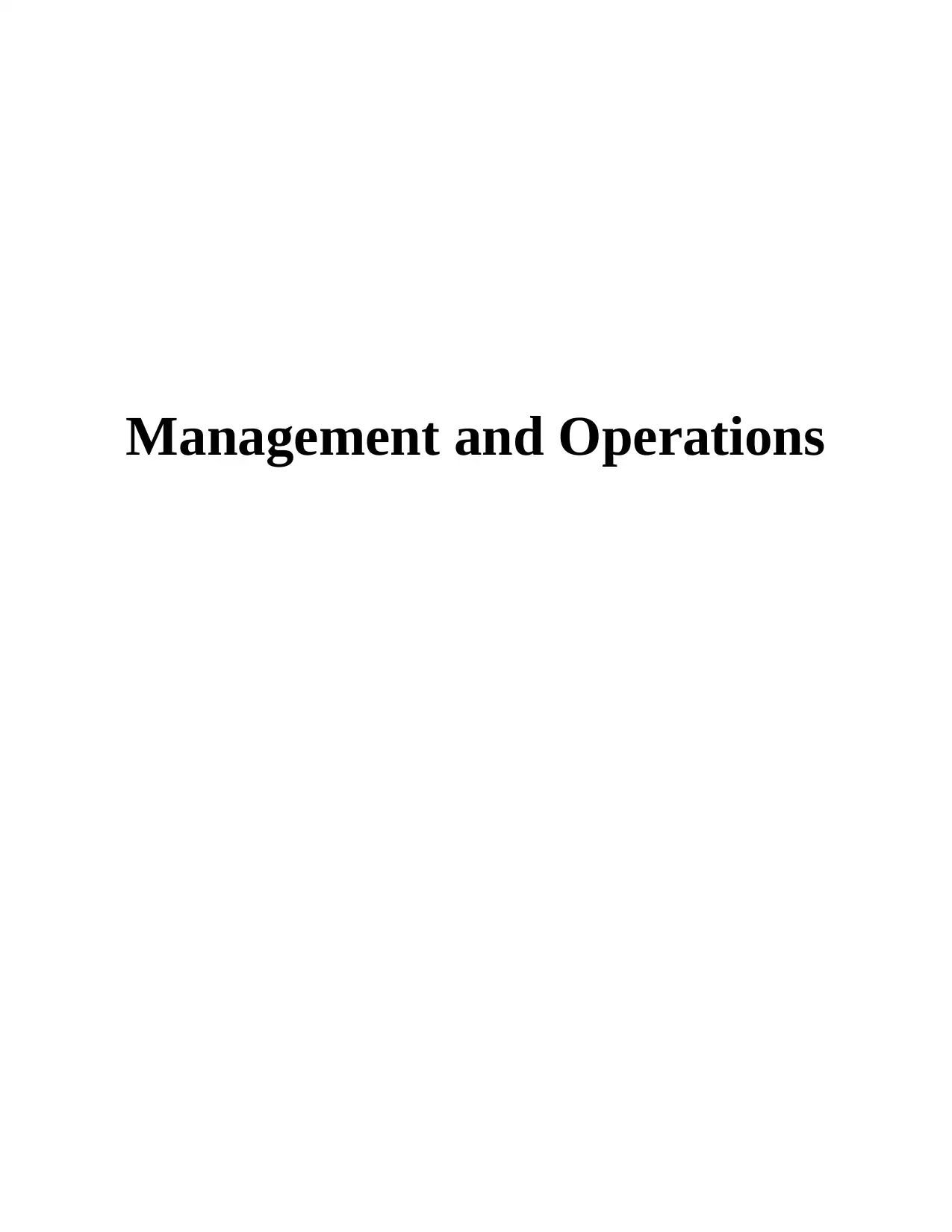
Management and Operations
Paraphrase This Document
Need a fresh take? Get an instant paraphrase of this document with our AI Paraphraser
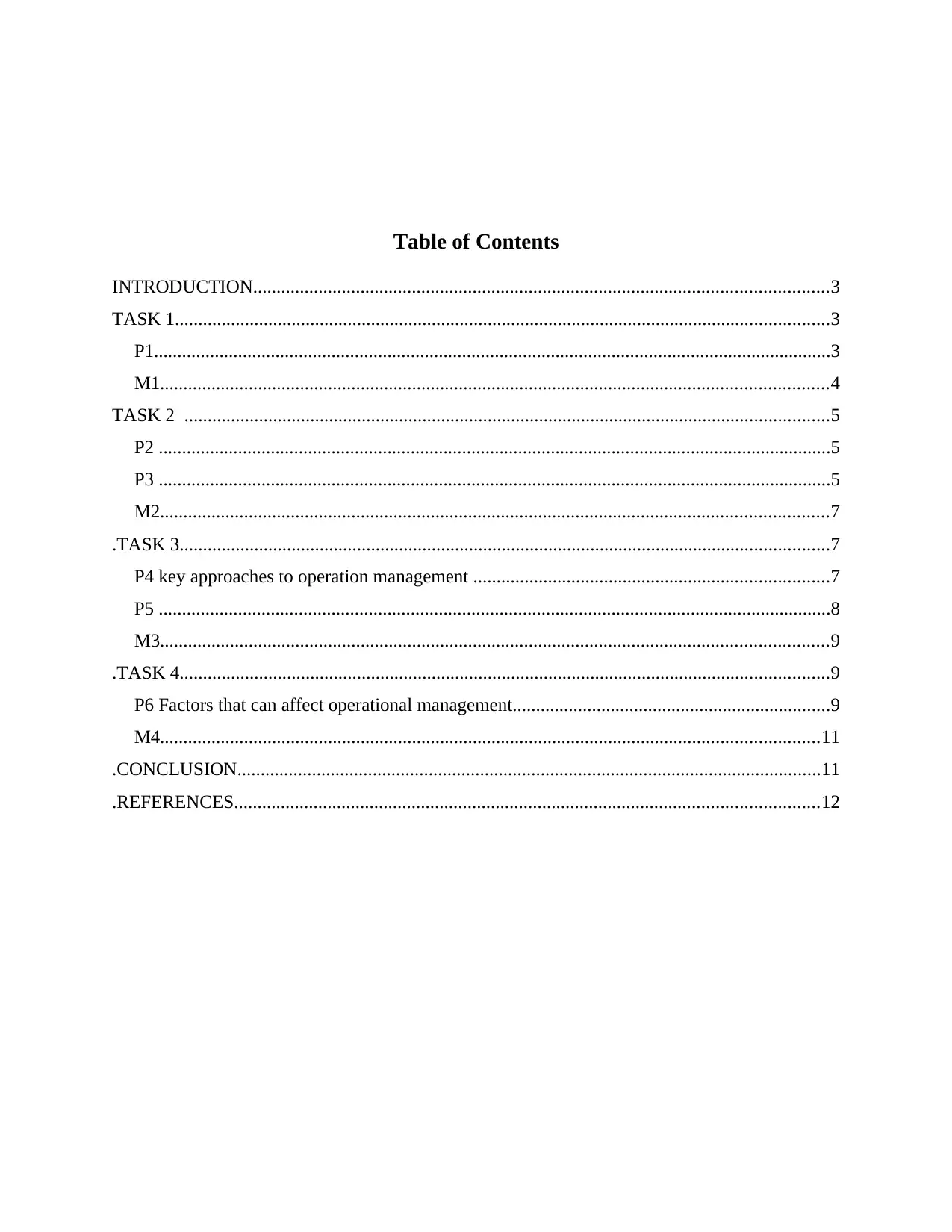
Table of Contents
INTRODUCTION...........................................................................................................................3
TASK 1............................................................................................................................................3
P1.................................................................................................................................................3
M1...............................................................................................................................................4
TASK 2 ..........................................................................................................................................5
P2 ................................................................................................................................................5
P3 ................................................................................................................................................5
M2...............................................................................................................................................7
.TASK 3...........................................................................................................................................7
P4 key approaches to operation management ............................................................................7
P5 ................................................................................................................................................8
M3...............................................................................................................................................9
.TASK 4...........................................................................................................................................9
P6 Factors that can affect operational management....................................................................9
M4.............................................................................................................................................11
.CONCLUSION.............................................................................................................................11
.REFERENCES.............................................................................................................................12
INTRODUCTION...........................................................................................................................3
TASK 1............................................................................................................................................3
P1.................................................................................................................................................3
M1...............................................................................................................................................4
TASK 2 ..........................................................................................................................................5
P2 ................................................................................................................................................5
P3 ................................................................................................................................................5
M2...............................................................................................................................................7
.TASK 3...........................................................................................................................................7
P4 key approaches to operation management ............................................................................7
P5 ................................................................................................................................................8
M3...............................................................................................................................................9
.TASK 4...........................................................................................................................................9
P6 Factors that can affect operational management....................................................................9
M4.............................................................................................................................................11
.CONCLUSION.............................................................................................................................11
.REFERENCES.............................................................................................................................12
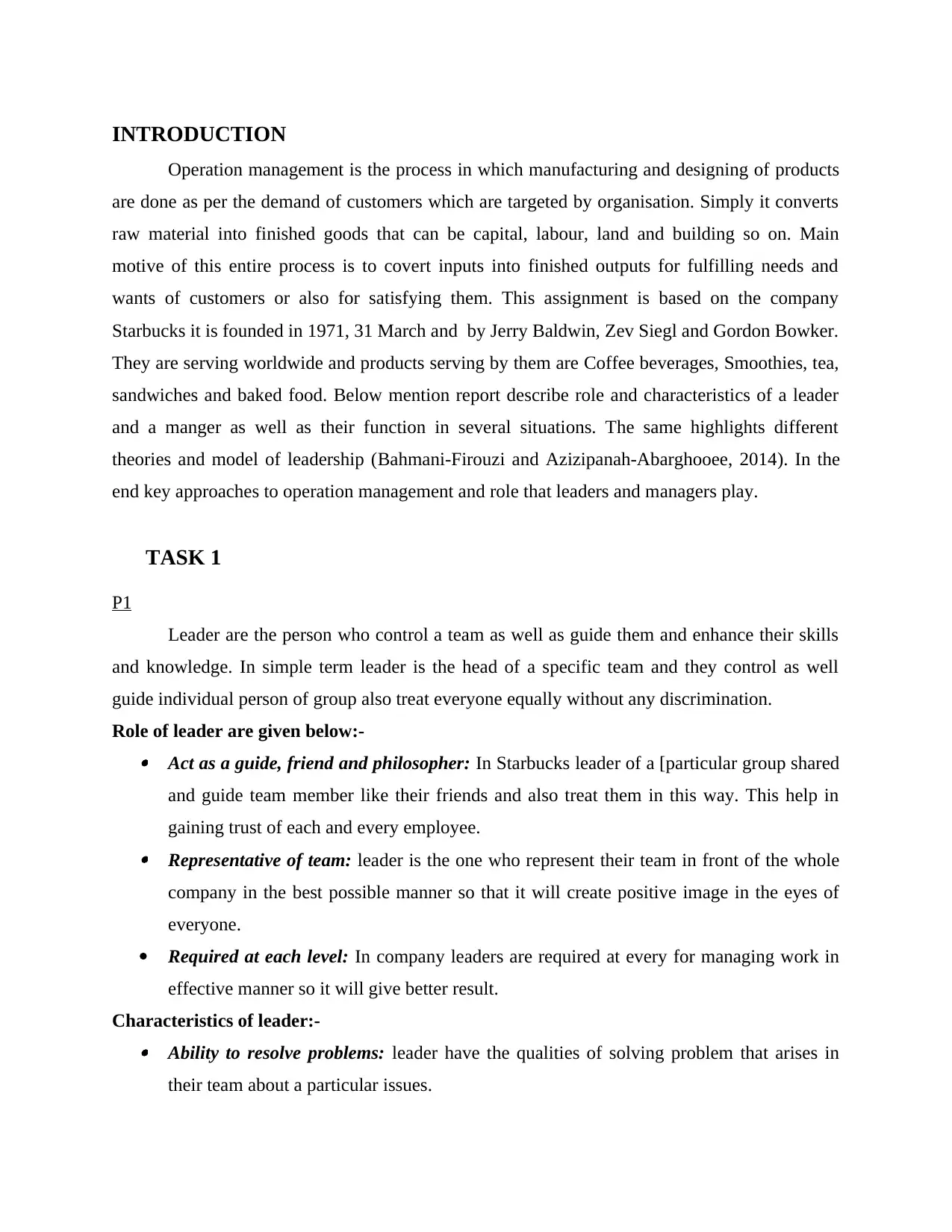
INTRODUCTION
Operation management is the process in which manufacturing and designing of products
are done as per the demand of customers which are targeted by organisation. Simply it converts
raw material into finished goods that can be capital, labour, land and building so on. Main
motive of this entire process is to covert inputs into finished outputs for fulfilling needs and
wants of customers or also for satisfying them. This assignment is based on the company
Starbucks it is founded in 1971, 31 March and by Jerry Baldwin, Zev Siegl and Gordon Bowker.
They are serving worldwide and products serving by them are Coffee beverages, Smoothies, tea,
sandwiches and baked food. Below mention report describe role and characteristics of a leader
and a manger as well as their function in several situations. The same highlights different
theories and model of leadership (Bahmani-Firouzi and Azizipanah-Abarghooee, 2014). In the
end key approaches to operation management and role that leaders and managers play.
TASK 1
P1
Leader are the person who control a team as well as guide them and enhance their skills
and knowledge. In simple term leader is the head of a specific team and they control as well
guide individual person of group also treat everyone equally without any discrimination.
Role of leader are given below:- Act as a guide, friend and philosopher: In Starbucks leader of a [particular group shared
and guide team member like their friends and also treat them in this way. This help in
gaining trust of each and every employee. Representative of team: leader is the one who represent their team in front of the whole
company in the best possible manner so that it will create positive image in the eyes of
everyone.
Required at each level: In company leaders are required at every for managing work in
effective manner so it will give better result.
Characteristics of leader:- Ability to resolve problems: leader have the qualities of solving problem that arises in
their team about a particular issues.
Operation management is the process in which manufacturing and designing of products
are done as per the demand of customers which are targeted by organisation. Simply it converts
raw material into finished goods that can be capital, labour, land and building so on. Main
motive of this entire process is to covert inputs into finished outputs for fulfilling needs and
wants of customers or also for satisfying them. This assignment is based on the company
Starbucks it is founded in 1971, 31 March and by Jerry Baldwin, Zev Siegl and Gordon Bowker.
They are serving worldwide and products serving by them are Coffee beverages, Smoothies, tea,
sandwiches and baked food. Below mention report describe role and characteristics of a leader
and a manger as well as their function in several situations. The same highlights different
theories and model of leadership (Bahmani-Firouzi and Azizipanah-Abarghooee, 2014). In the
end key approaches to operation management and role that leaders and managers play.
TASK 1
P1
Leader are the person who control a team as well as guide them and enhance their skills
and knowledge. In simple term leader is the head of a specific team and they control as well
guide individual person of group also treat everyone equally without any discrimination.
Role of leader are given below:- Act as a guide, friend and philosopher: In Starbucks leader of a [particular group shared
and guide team member like their friends and also treat them in this way. This help in
gaining trust of each and every employee. Representative of team: leader is the one who represent their team in front of the whole
company in the best possible manner so that it will create positive image in the eyes of
everyone.
Required at each level: In company leaders are required at every for managing work in
effective manner so it will give better result.
Characteristics of leader:- Ability to resolve problems: leader have the qualities of solving problem that arises in
their team about a particular issues.
⊘ This is a preview!⊘
Do you want full access?
Subscribe today to unlock all pages.

Trusted by 1+ million students worldwide
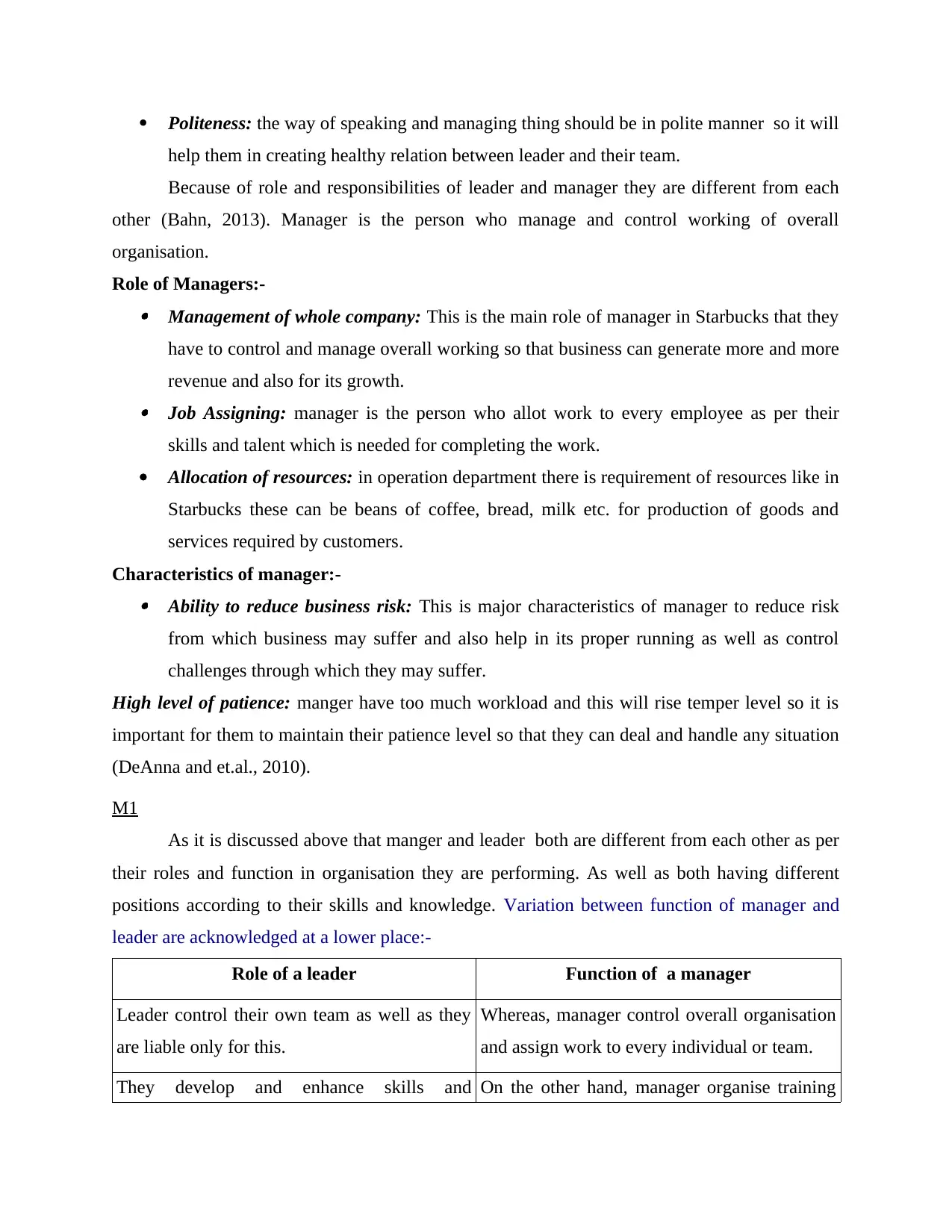
Politeness: the way of speaking and managing thing should be in polite manner so it will
help them in creating healthy relation between leader and their team.
Because of role and responsibilities of leader and manager they are different from each
other (Bahn, 2013). Manager is the person who manage and control working of overall
organisation.
Role of Managers:- Management of whole company: This is the main role of manager in Starbucks that they
have to control and manage overall working so that business can generate more and more
revenue and also for its growth. Job Assigning: manager is the person who allot work to every employee as per their
skills and talent which is needed for completing the work.
Allocation of resources: in operation department there is requirement of resources like in
Starbucks these can be beans of coffee, bread, milk etc. for production of goods and
services required by customers.
Characteristics of manager:- Ability to reduce business risk: This is major characteristics of manager to reduce risk
from which business may suffer and also help in its proper running as well as control
challenges through which they may suffer.
High level of patience: manger have too much workload and this will rise temper level so it is
important for them to maintain their patience level so that they can deal and handle any situation
(DeAnna and et.al., 2010).
M1
As it is discussed above that manger and leader both are different from each other as per
their roles and function in organisation they are performing. As well as both having different
positions according to their skills and knowledge. Variation between function of manager and
leader are acknowledged at a lower place:-
Role of a leader Function of a manager
Leader control their own team as well as they
are liable only for this.
Whereas, manager control overall organisation
and assign work to every individual or team.
They develop and enhance skills and On the other hand, manager organise training
help them in creating healthy relation between leader and their team.
Because of role and responsibilities of leader and manager they are different from each
other (Bahn, 2013). Manager is the person who manage and control working of overall
organisation.
Role of Managers:- Management of whole company: This is the main role of manager in Starbucks that they
have to control and manage overall working so that business can generate more and more
revenue and also for its growth. Job Assigning: manager is the person who allot work to every employee as per their
skills and talent which is needed for completing the work.
Allocation of resources: in operation department there is requirement of resources like in
Starbucks these can be beans of coffee, bread, milk etc. for production of goods and
services required by customers.
Characteristics of manager:- Ability to reduce business risk: This is major characteristics of manager to reduce risk
from which business may suffer and also help in its proper running as well as control
challenges through which they may suffer.
High level of patience: manger have too much workload and this will rise temper level so it is
important for them to maintain their patience level so that they can deal and handle any situation
(DeAnna and et.al., 2010).
M1
As it is discussed above that manger and leader both are different from each other as per
their roles and function in organisation they are performing. As well as both having different
positions according to their skills and knowledge. Variation between function of manager and
leader are acknowledged at a lower place:-
Role of a leader Function of a manager
Leader control their own team as well as they
are liable only for this.
Whereas, manager control overall organisation
and assign work to every individual or team.
They develop and enhance skills and On the other hand, manager organise training
Paraphrase This Document
Need a fresh take? Get an instant paraphrase of this document with our AI Paraphraser
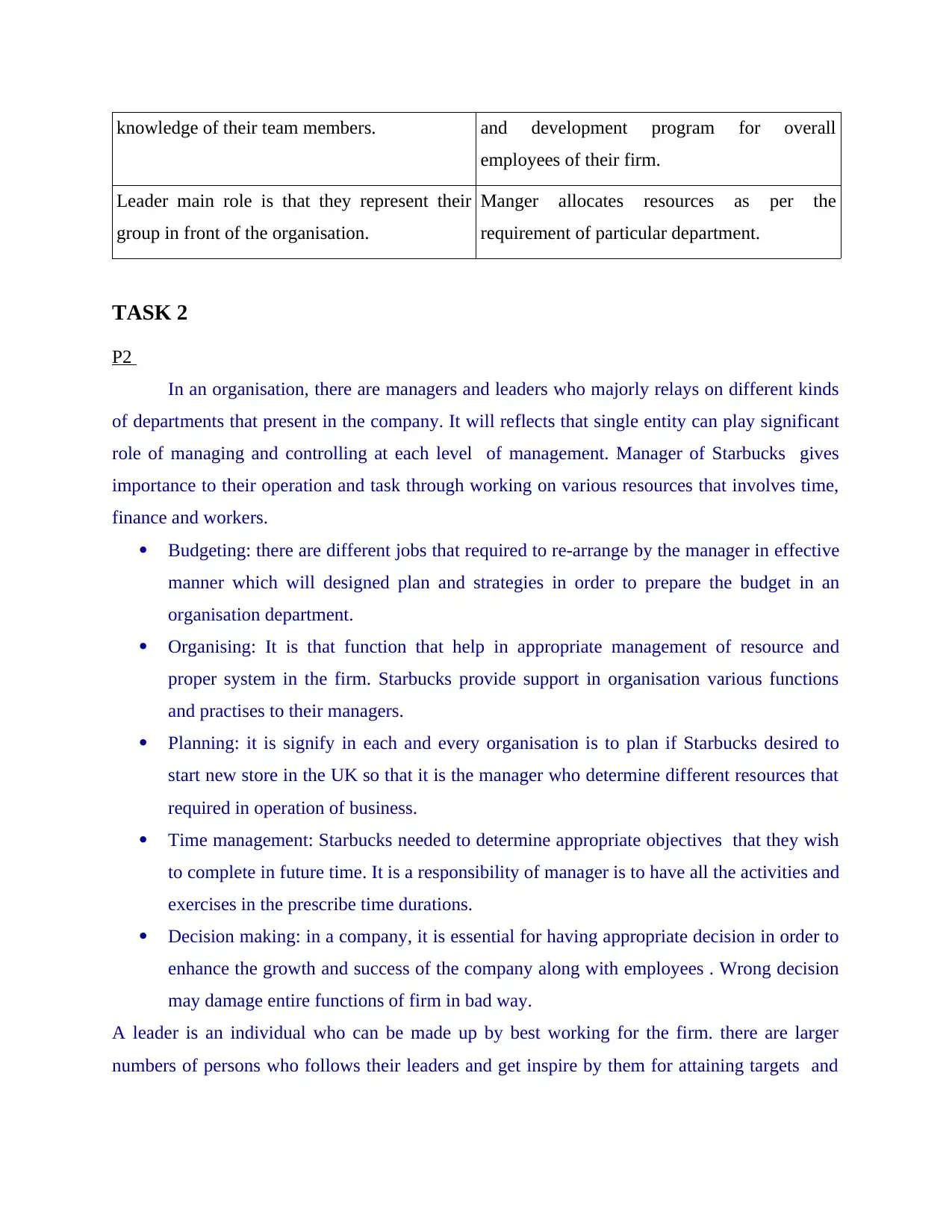
knowledge of their team members. and development program for overall
employees of their firm.
Leader main role is that they represent their
group in front of the organisation.
Manger allocates resources as per the
requirement of particular department.
TASK 2
P2
In an organisation, there are managers and leaders who majorly relays on different kinds
of departments that present in the company. It will reflects that single entity can play significant
role of managing and controlling at each level of management. Manager of Starbucks gives
importance to their operation and task through working on various resources that involves time,
finance and workers.
Budgeting: there are different jobs that required to re-arrange by the manager in effective
manner which will designed plan and strategies in order to prepare the budget in an
organisation department.
Organising: It is that function that help in appropriate management of resource and
proper system in the firm. Starbucks provide support in organisation various functions
and practises to their managers.
Planning: it is signify in each and every organisation is to plan if Starbucks desired to
start new store in the UK so that it is the manager who determine different resources that
required in operation of business.
Time management: Starbucks needed to determine appropriate objectives that they wish
to complete in future time. It is a responsibility of manager is to have all the activities and
exercises in the prescribe time durations.
Decision making: in a company, it is essential for having appropriate decision in order to
enhance the growth and success of the company along with employees . Wrong decision
may damage entire functions of firm in bad way.
A leader is an individual who can be made up by best working for the firm. there are larger
numbers of persons who follows their leaders and get inspire by them for attaining targets and
employees of their firm.
Leader main role is that they represent their
group in front of the organisation.
Manger allocates resources as per the
requirement of particular department.
TASK 2
P2
In an organisation, there are managers and leaders who majorly relays on different kinds
of departments that present in the company. It will reflects that single entity can play significant
role of managing and controlling at each level of management. Manager of Starbucks gives
importance to their operation and task through working on various resources that involves time,
finance and workers.
Budgeting: there are different jobs that required to re-arrange by the manager in effective
manner which will designed plan and strategies in order to prepare the budget in an
organisation department.
Organising: It is that function that help in appropriate management of resource and
proper system in the firm. Starbucks provide support in organisation various functions
and practises to their managers.
Planning: it is signify in each and every organisation is to plan if Starbucks desired to
start new store in the UK so that it is the manager who determine different resources that
required in operation of business.
Time management: Starbucks needed to determine appropriate objectives that they wish
to complete in future time. It is a responsibility of manager is to have all the activities and
exercises in the prescribe time durations.
Decision making: in a company, it is essential for having appropriate decision in order to
enhance the growth and success of the company along with employees . Wrong decision
may damage entire functions of firm in bad way.
A leader is an individual who can be made up by best working for the firm. there are larger
numbers of persons who follows their leaders and get inspire by them for attaining targets and
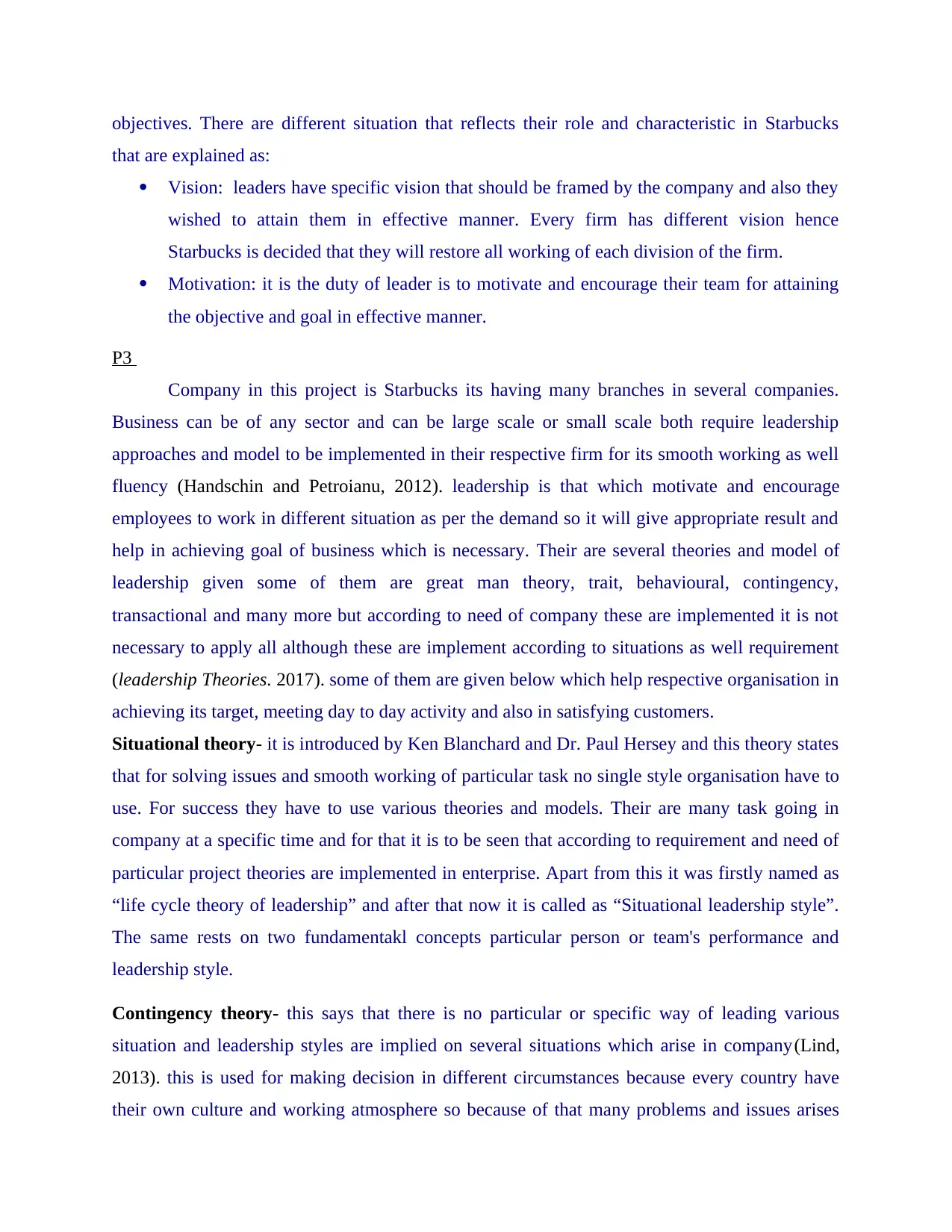
objectives. There are different situation that reflects their role and characteristic in Starbucks
that are explained as:
Vision: leaders have specific vision that should be framed by the company and also they
wished to attain them in effective manner. Every firm has different vision hence
Starbucks is decided that they will restore all working of each division of the firm.
Motivation: it is the duty of leader is to motivate and encourage their team for attaining
the objective and goal in effective manner.
P3
Company in this project is Starbucks its having many branches in several companies.
Business can be of any sector and can be large scale or small scale both require leadership
approaches and model to be implemented in their respective firm for its smooth working as well
fluency (Handschin and Petroianu, 2012). leadership is that which motivate and encourage
employees to work in different situation as per the demand so it will give appropriate result and
help in achieving goal of business which is necessary. Their are several theories and model of
leadership given some of them are great man theory, trait, behavioural, contingency,
transactional and many more but according to need of company these are implemented it is not
necessary to apply all although these are implement according to situations as well requirement
(leadership Theories. 2017). some of them are given below which help respective organisation in
achieving its target, meeting day to day activity and also in satisfying customers.
Situational theory- it is introduced by Ken Blanchard and Dr. Paul Hersey and this theory states
that for solving issues and smooth working of particular task no single style organisation have to
use. For success they have to use various theories and models. Their are many task going in
company at a specific time and for that it is to be seen that according to requirement and need of
particular project theories are implemented in enterprise. Apart from this it was firstly named as
“life cycle theory of leadership” and after that now it is called as “Situational leadership style”.
The same rests on two fundamentakl concepts particular person or team's performance and
leadership style.
Contingency theory- this says that there is no particular or specific way of leading various
situation and leadership styles are implied on several situations which arise in company(Lind,
2013). this is used for making decision in different circumstances because every country have
their own culture and working atmosphere so because of that many problems and issues arises
that are explained as:
Vision: leaders have specific vision that should be framed by the company and also they
wished to attain them in effective manner. Every firm has different vision hence
Starbucks is decided that they will restore all working of each division of the firm.
Motivation: it is the duty of leader is to motivate and encourage their team for attaining
the objective and goal in effective manner.
P3
Company in this project is Starbucks its having many branches in several companies.
Business can be of any sector and can be large scale or small scale both require leadership
approaches and model to be implemented in their respective firm for its smooth working as well
fluency (Handschin and Petroianu, 2012). leadership is that which motivate and encourage
employees to work in different situation as per the demand so it will give appropriate result and
help in achieving goal of business which is necessary. Their are several theories and model of
leadership given some of them are great man theory, trait, behavioural, contingency,
transactional and many more but according to need of company these are implemented it is not
necessary to apply all although these are implement according to situations as well requirement
(leadership Theories. 2017). some of them are given below which help respective organisation in
achieving its target, meeting day to day activity and also in satisfying customers.
Situational theory- it is introduced by Ken Blanchard and Dr. Paul Hersey and this theory states
that for solving issues and smooth working of particular task no single style organisation have to
use. For success they have to use various theories and models. Their are many task going in
company at a specific time and for that it is to be seen that according to requirement and need of
particular project theories are implemented in enterprise. Apart from this it was firstly named as
“life cycle theory of leadership” and after that now it is called as “Situational leadership style”.
The same rests on two fundamentakl concepts particular person or team's performance and
leadership style.
Contingency theory- this says that there is no particular or specific way of leading various
situation and leadership styles are implied on several situations which arise in company(Lind,
2013). this is used for making decision in different circumstances because every country have
their own culture and working atmosphere so because of that many problems and issues arises
⊘ This is a preview!⊘
Do you want full access?
Subscribe today to unlock all pages.

Trusted by 1+ million students worldwide
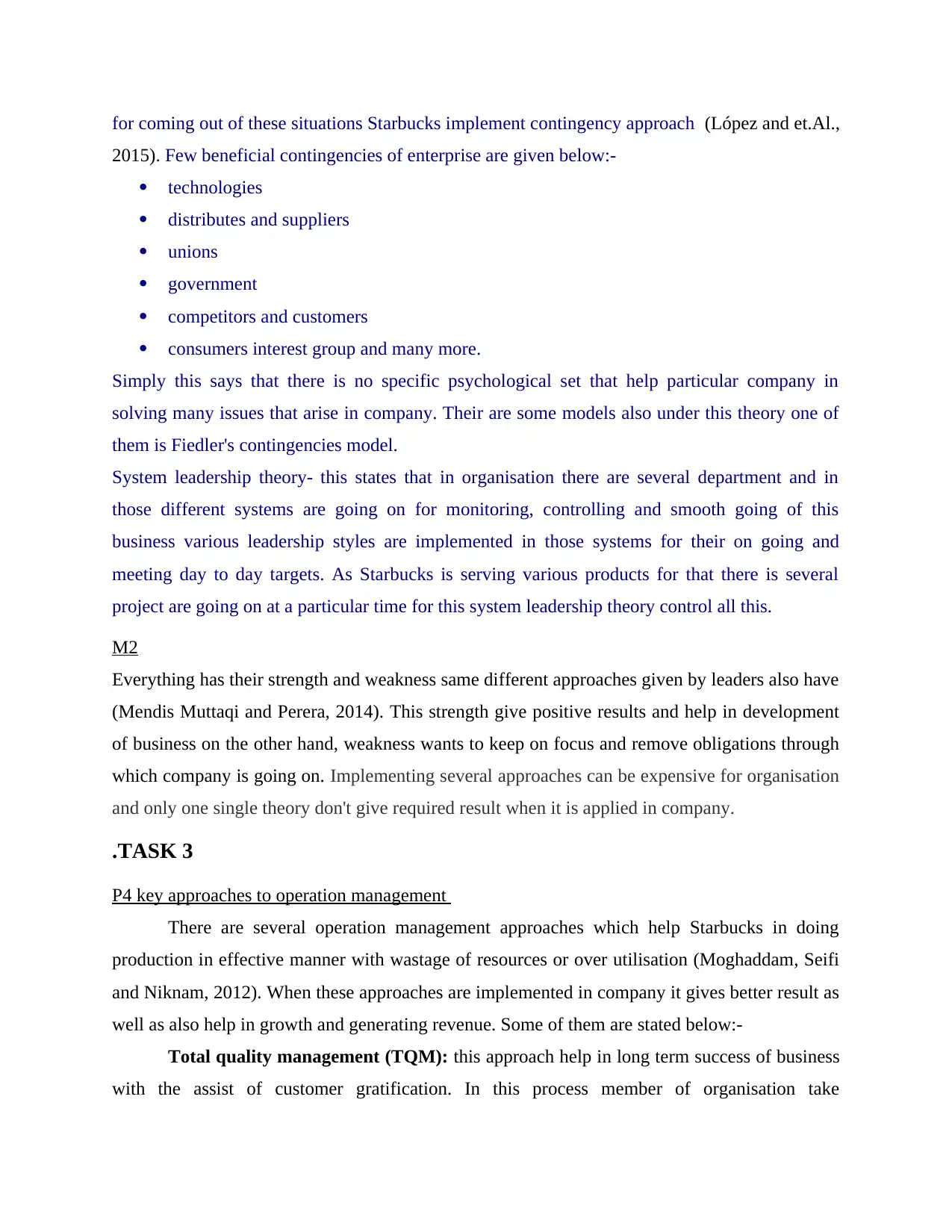
for coming out of these situations Starbucks implement contingency approach (López and et.Al.,
2015). Few beneficial contingencies of enterprise are given below:-
technologies
distributes and suppliers
unions
government
competitors and customers
consumers interest group and many more.
Simply this says that there is no specific psychological set that help particular company in
solving many issues that arise in company. Their are some models also under this theory one of
them is Fiedler's contingencies model.
System leadership theory- this states that in organisation there are several department and in
those different systems are going on for monitoring, controlling and smooth going of this
business various leadership styles are implemented in those systems for their on going and
meeting day to day targets. As Starbucks is serving various products for that there is several
project are going on at a particular time for this system leadership theory control all this.
M2
Everything has their strength and weakness same different approaches given by leaders also have
(Mendis Muttaqi and Perera, 2014). This strength give positive results and help in development
of business on the other hand, weakness wants to keep on focus and remove obligations through
which company is going on. Implementing several approaches can be expensive for organisation
and only one single theory don't give required result when it is applied in company.
.TASK 3
P4 key approaches to operation management
There are several operation management approaches which help Starbucks in doing
production in effective manner with wastage of resources or over utilisation (Moghaddam, Seifi
and Niknam, 2012). When these approaches are implemented in company it gives better result as
well as also help in growth and generating revenue. Some of them are stated below:-
Total quality management (TQM): this approach help in long term success of business
with the assist of customer gratification. In this process member of organisation take
2015). Few beneficial contingencies of enterprise are given below:-
technologies
distributes and suppliers
unions
government
competitors and customers
consumers interest group and many more.
Simply this says that there is no specific psychological set that help particular company in
solving many issues that arise in company. Their are some models also under this theory one of
them is Fiedler's contingencies model.
System leadership theory- this states that in organisation there are several department and in
those different systems are going on for monitoring, controlling and smooth going of this
business various leadership styles are implemented in those systems for their on going and
meeting day to day targets. As Starbucks is serving various products for that there is several
project are going on at a particular time for this system leadership theory control all this.
M2
Everything has their strength and weakness same different approaches given by leaders also have
(Mendis Muttaqi and Perera, 2014). This strength give positive results and help in development
of business on the other hand, weakness wants to keep on focus and remove obligations through
which company is going on. Implementing several approaches can be expensive for organisation
and only one single theory don't give required result when it is applied in company.
.TASK 3
P4 key approaches to operation management
There are several operation management approaches which help Starbucks in doing
production in effective manner with wastage of resources or over utilisation (Moghaddam, Seifi
and Niknam, 2012). When these approaches are implemented in company it gives better result as
well as also help in growth and generating revenue. Some of them are stated below:-
Total quality management (TQM): this approach help in long term success of business
with the assist of customer gratification. In this process member of organisation take
Paraphrase This Document
Need a fresh take? Get an instant paraphrase of this document with our AI Paraphraser
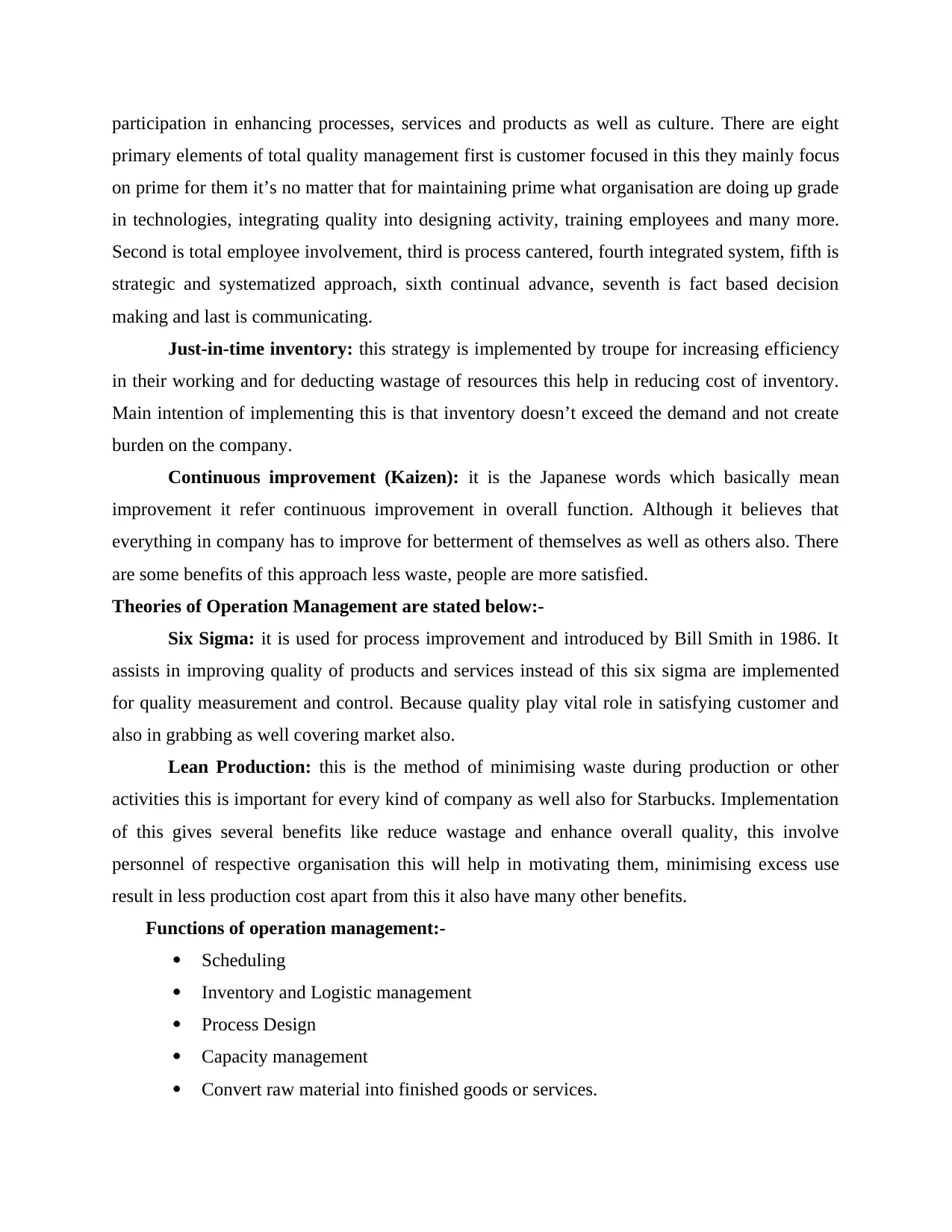
participation in enhancing processes, services and products as well as culture. There are eight
primary elements of total quality management first is customer focused in this they mainly focus
on prime for them it’s no matter that for maintaining prime what organisation are doing up grade
in technologies, integrating quality into designing activity, training employees and many more.
Second is total employee involvement, third is process cantered, fourth integrated system, fifth is
strategic and systematized approach, sixth continual advance, seventh is fact based decision
making and last is communicating.
Just-in-time inventory: this strategy is implemented by troupe for increasing efficiency
in their working and for deducting wastage of resources this help in reducing cost of inventory.
Main intention of implementing this is that inventory doesn’t exceed the demand and not create
burden on the company.
Continuous improvement (Kaizen): it is the Japanese words which basically mean
improvement it refer continuous improvement in overall function. Although it believes that
everything in company has to improve for betterment of themselves as well as others also. There
are some benefits of this approach less waste, people are more satisfied.
Theories of Operation Management are stated below:-
Six Sigma: it is used for process improvement and introduced by Bill Smith in 1986. It
assists in improving quality of products and services instead of this six sigma are implemented
for quality measurement and control. Because quality play vital role in satisfying customer and
also in grabbing as well covering market also.
Lean Production: this is the method of minimising waste during production or other
activities this is important for every kind of company as well also for Starbucks. Implementation
of this gives several benefits like reduce wastage and enhance overall quality, this involve
personnel of respective organisation this will help in motivating them, minimising excess use
result in less production cost apart from this it also have many other benefits.
Functions of operation management:-
Scheduling
Inventory and Logistic management
Process Design
Capacity management
Convert raw material into finished goods or services.
primary elements of total quality management first is customer focused in this they mainly focus
on prime for them it’s no matter that for maintaining prime what organisation are doing up grade
in technologies, integrating quality into designing activity, training employees and many more.
Second is total employee involvement, third is process cantered, fourth integrated system, fifth is
strategic and systematized approach, sixth continual advance, seventh is fact based decision
making and last is communicating.
Just-in-time inventory: this strategy is implemented by troupe for increasing efficiency
in their working and for deducting wastage of resources this help in reducing cost of inventory.
Main intention of implementing this is that inventory doesn’t exceed the demand and not create
burden on the company.
Continuous improvement (Kaizen): it is the Japanese words which basically mean
improvement it refer continuous improvement in overall function. Although it believes that
everything in company has to improve for betterment of themselves as well as others also. There
are some benefits of this approach less waste, people are more satisfied.
Theories of Operation Management are stated below:-
Six Sigma: it is used for process improvement and introduced by Bill Smith in 1986. It
assists in improving quality of products and services instead of this six sigma are implemented
for quality measurement and control. Because quality play vital role in satisfying customer and
also in grabbing as well covering market also.
Lean Production: this is the method of minimising waste during production or other
activities this is important for every kind of company as well also for Starbucks. Implementation
of this gives several benefits like reduce wastage and enhance overall quality, this involve
personnel of respective organisation this will help in motivating them, minimising excess use
result in less production cost apart from this it also have many other benefits.
Functions of operation management:-
Scheduling
Inventory and Logistic management
Process Design
Capacity management
Convert raw material into finished goods or services.
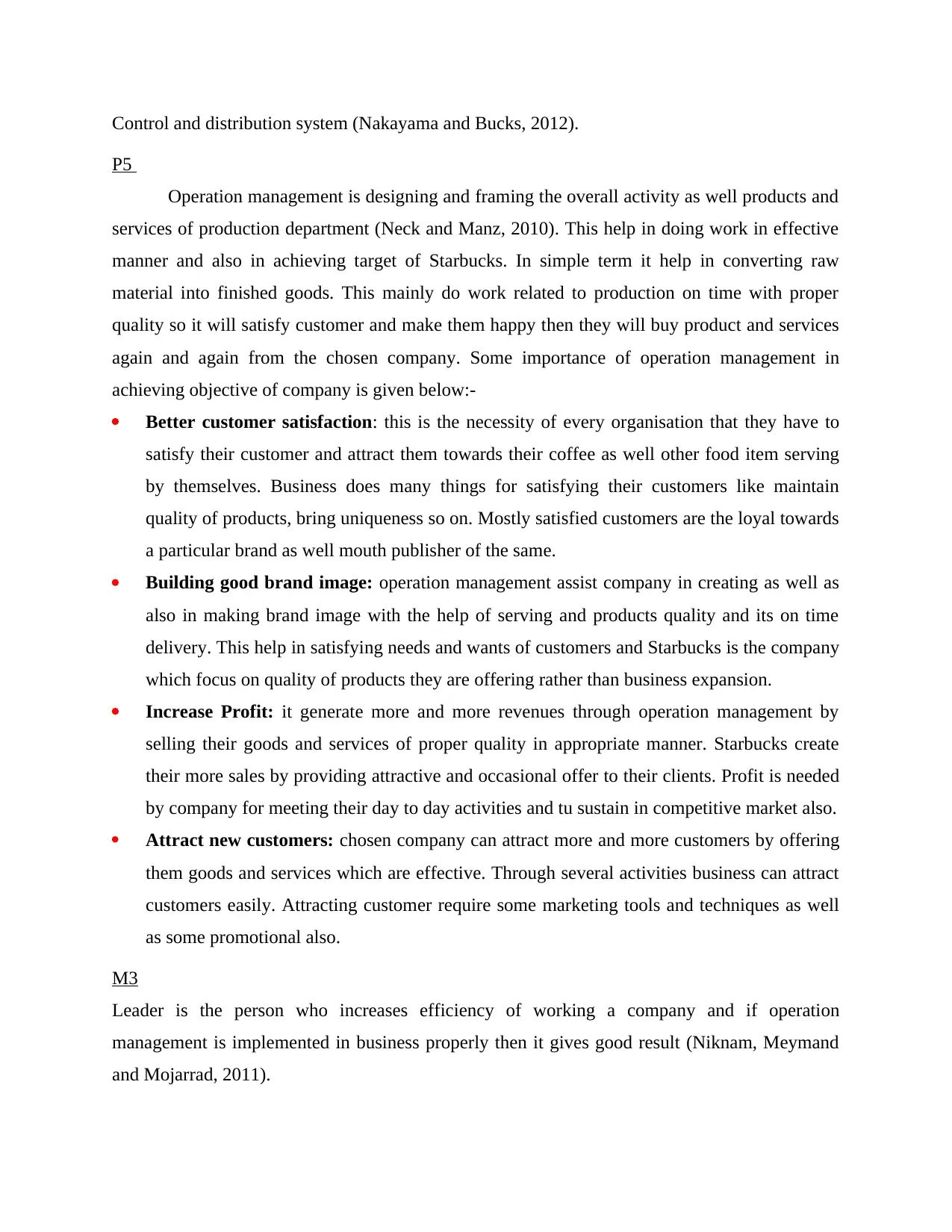
Control and distribution system (Nakayama and Bucks, 2012).
P5
Operation management is designing and framing the overall activity as well products and
services of production department (Neck and Manz, 2010). This help in doing work in effective
manner and also in achieving target of Starbucks. In simple term it help in converting raw
material into finished goods. This mainly do work related to production on time with proper
quality so it will satisfy customer and make them happy then they will buy product and services
again and again from the chosen company. Some importance of operation management in
achieving objective of company is given below:-
Better customer satisfaction: this is the necessity of every organisation that they have to
satisfy their customer and attract them towards their coffee as well other food item serving
by themselves. Business does many things for satisfying their customers like maintain
quality of products, bring uniqueness so on. Mostly satisfied customers are the loyal towards
a particular brand as well mouth publisher of the same.
Building good brand image: operation management assist company in creating as well as
also in making brand image with the help of serving and products quality and its on time
delivery. This help in satisfying needs and wants of customers and Starbucks is the company
which focus on quality of products they are offering rather than business expansion.
Increase Profit: it generate more and more revenues through operation management by
selling their goods and services of proper quality in appropriate manner. Starbucks create
their more sales by providing attractive and occasional offer to their clients. Profit is needed
by company for meeting their day to day activities and tu sustain in competitive market also.
Attract new customers: chosen company can attract more and more customers by offering
them goods and services which are effective. Through several activities business can attract
customers easily. Attracting customer require some marketing tools and techniques as well
as some promotional also.
M3
Leader is the person who increases efficiency of working a company and if operation
management is implemented in business properly then it gives good result (Niknam, Meymand
and Mojarrad, 2011).
P5
Operation management is designing and framing the overall activity as well products and
services of production department (Neck and Manz, 2010). This help in doing work in effective
manner and also in achieving target of Starbucks. In simple term it help in converting raw
material into finished goods. This mainly do work related to production on time with proper
quality so it will satisfy customer and make them happy then they will buy product and services
again and again from the chosen company. Some importance of operation management in
achieving objective of company is given below:-
Better customer satisfaction: this is the necessity of every organisation that they have to
satisfy their customer and attract them towards their coffee as well other food item serving
by themselves. Business does many things for satisfying their customers like maintain
quality of products, bring uniqueness so on. Mostly satisfied customers are the loyal towards
a particular brand as well mouth publisher of the same.
Building good brand image: operation management assist company in creating as well as
also in making brand image with the help of serving and products quality and its on time
delivery. This help in satisfying needs and wants of customers and Starbucks is the company
which focus on quality of products they are offering rather than business expansion.
Increase Profit: it generate more and more revenues through operation management by
selling their goods and services of proper quality in appropriate manner. Starbucks create
their more sales by providing attractive and occasional offer to their clients. Profit is needed
by company for meeting their day to day activities and tu sustain in competitive market also.
Attract new customers: chosen company can attract more and more customers by offering
them goods and services which are effective. Through several activities business can attract
customers easily. Attracting customer require some marketing tools and techniques as well
as some promotional also.
M3
Leader is the person who increases efficiency of working a company and if operation
management is implemented in business properly then it gives good result (Niknam, Meymand
and Mojarrad, 2011).
⊘ This is a preview!⊘
Do you want full access?
Subscribe today to unlock all pages.

Trusted by 1+ million students worldwide
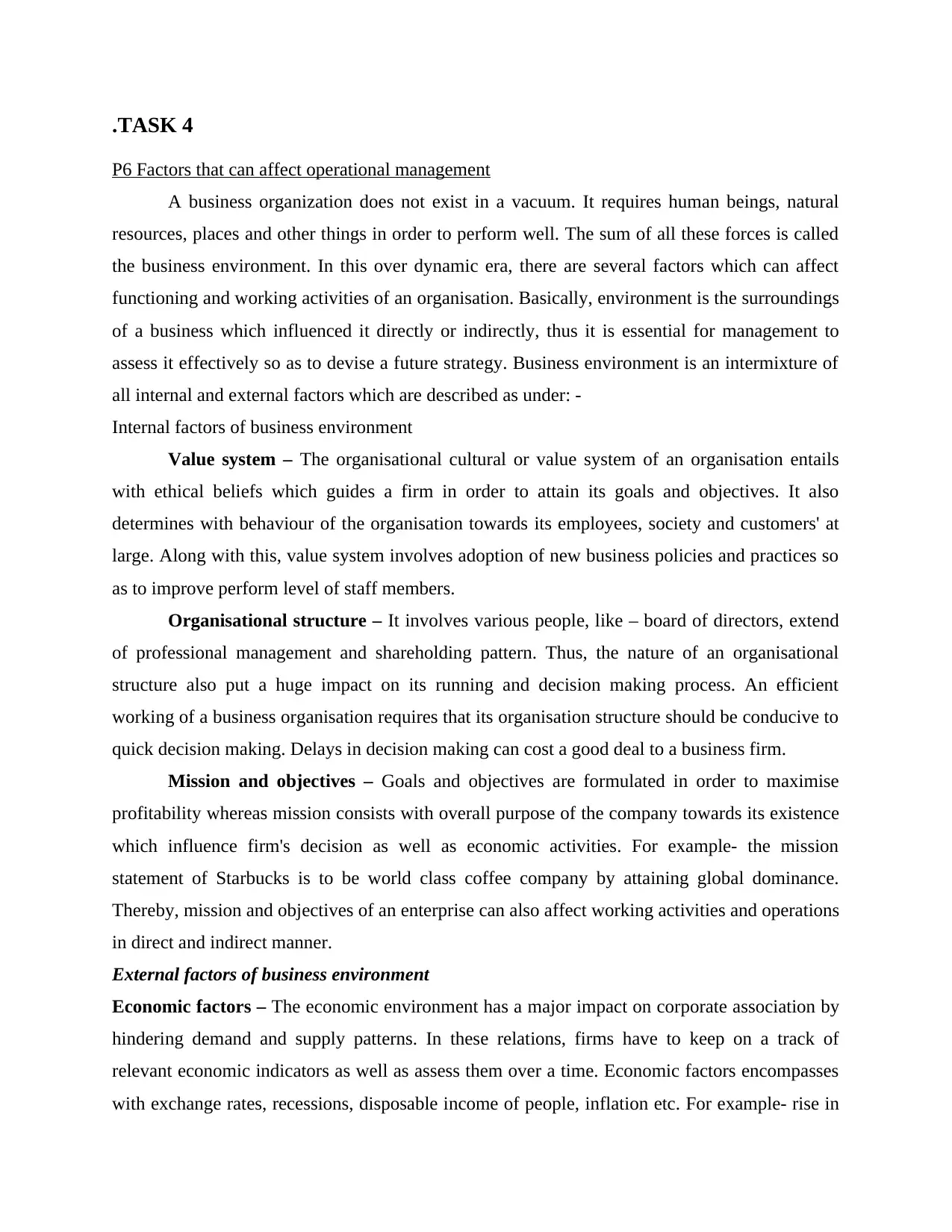
.TASK 4
P6 Factors that can affect operational management
A business organization does not exist in a vacuum. It requires human beings, natural
resources, places and other things in order to perform well. The sum of all these forces is called
the business environment. In this over dynamic era, there are several factors which can affect
functioning and working activities of an organisation. Basically, environment is the surroundings
of a business which influenced it directly or indirectly, thus it is essential for management to
assess it effectively so as to devise a future strategy. Business environment is an intermixture of
all internal and external factors which are described as under: -
Internal factors of business environment
Value system – The organisational cultural or value system of an organisation entails
with ethical beliefs which guides a firm in order to attain its goals and objectives. It also
determines with behaviour of the organisation towards its employees, society and customers' at
large. Along with this, value system involves adoption of new business policies and practices so
as to improve perform level of staff members.
Organisational structure – It involves various people, like – board of directors, extend
of professional management and shareholding pattern. Thus, the nature of an organisational
structure also put a huge impact on its running and decision making process. An efficient
working of a business organisation requires that its organisation structure should be conducive to
quick decision making. Delays in decision making can cost a good deal to a business firm.
Mission and objectives – Goals and objectives are formulated in order to maximise
profitability whereas mission consists with overall purpose of the company towards its existence
which influence firm's decision as well as economic activities. For example- the mission
statement of Starbucks is to be world class coffee company by attaining global dominance.
Thereby, mission and objectives of an enterprise can also affect working activities and operations
in direct and indirect manner.
External factors of business environment
Economic factors – The economic environment has a major impact on corporate association by
hindering demand and supply patterns. In these relations, firms have to keep on a track of
relevant economic indicators as well as assess them over a time. Economic factors encompasses
with exchange rates, recessions, disposable income of people, inflation etc. For example- rise in
P6 Factors that can affect operational management
A business organization does not exist in a vacuum. It requires human beings, natural
resources, places and other things in order to perform well. The sum of all these forces is called
the business environment. In this over dynamic era, there are several factors which can affect
functioning and working activities of an organisation. Basically, environment is the surroundings
of a business which influenced it directly or indirectly, thus it is essential for management to
assess it effectively so as to devise a future strategy. Business environment is an intermixture of
all internal and external factors which are described as under: -
Internal factors of business environment
Value system – The organisational cultural or value system of an organisation entails
with ethical beliefs which guides a firm in order to attain its goals and objectives. It also
determines with behaviour of the organisation towards its employees, society and customers' at
large. Along with this, value system involves adoption of new business policies and practices so
as to improve perform level of staff members.
Organisational structure – It involves various people, like – board of directors, extend
of professional management and shareholding pattern. Thus, the nature of an organisational
structure also put a huge impact on its running and decision making process. An efficient
working of a business organisation requires that its organisation structure should be conducive to
quick decision making. Delays in decision making can cost a good deal to a business firm.
Mission and objectives – Goals and objectives are formulated in order to maximise
profitability whereas mission consists with overall purpose of the company towards its existence
which influence firm's decision as well as economic activities. For example- the mission
statement of Starbucks is to be world class coffee company by attaining global dominance.
Thereby, mission and objectives of an enterprise can also affect working activities and operations
in direct and indirect manner.
External factors of business environment
Economic factors – The economic environment has a major impact on corporate association by
hindering demand and supply patterns. In these relations, firms have to keep on a track of
relevant economic indicators as well as assess them over a time. Economic factors encompasses
with exchange rates, recessions, disposable income of people, inflation etc. For example- rise in
Paraphrase This Document
Need a fresh take? Get an instant paraphrase of this document with our AI Paraphraser
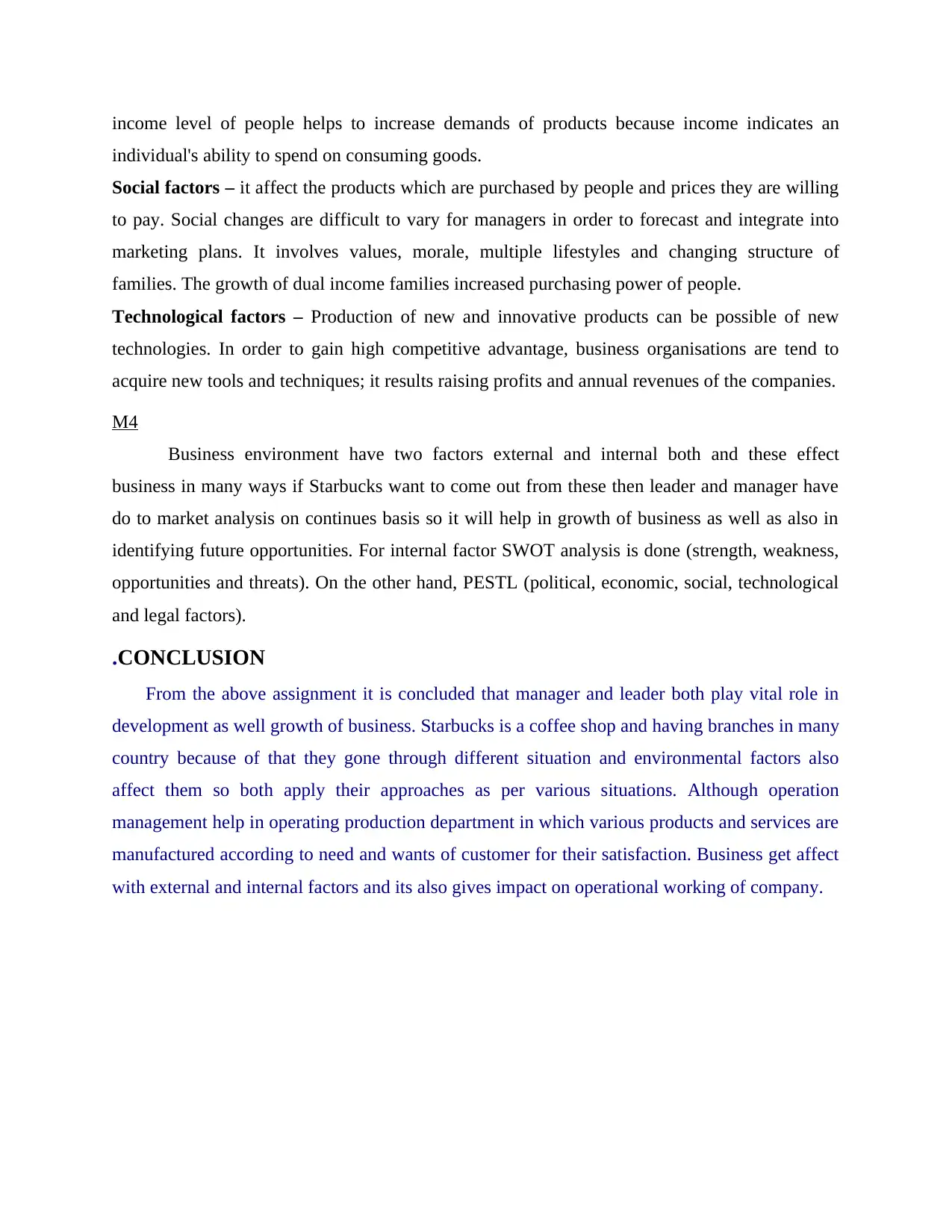
income level of people helps to increase demands of products because income indicates an
individual's ability to spend on consuming goods.
Social factors – it affect the products which are purchased by people and prices they are willing
to pay. Social changes are difficult to vary for managers in order to forecast and integrate into
marketing plans. It involves values, morale, multiple lifestyles and changing structure of
families. The growth of dual income families increased purchasing power of people.
Technological factors – Production of new and innovative products can be possible of new
technologies. In order to gain high competitive advantage, business organisations are tend to
acquire new tools and techniques; it results raising profits and annual revenues of the companies.
M4
Business environment have two factors external and internal both and these effect
business in many ways if Starbucks want to come out from these then leader and manager have
do to market analysis on continues basis so it will help in growth of business as well as also in
identifying future opportunities. For internal factor SWOT analysis is done (strength, weakness,
opportunities and threats). On the other hand, PESTL (political, economic, social, technological
and legal factors).
.CONCLUSION
From the above assignment it is concluded that manager and leader both play vital role in
development as well growth of business. Starbucks is a coffee shop and having branches in many
country because of that they gone through different situation and environmental factors also
affect them so both apply their approaches as per various situations. Although operation
management help in operating production department in which various products and services are
manufactured according to need and wants of customer for their satisfaction. Business get affect
with external and internal factors and its also gives impact on operational working of company.
individual's ability to spend on consuming goods.
Social factors – it affect the products which are purchased by people and prices they are willing
to pay. Social changes are difficult to vary for managers in order to forecast and integrate into
marketing plans. It involves values, morale, multiple lifestyles and changing structure of
families. The growth of dual income families increased purchasing power of people.
Technological factors – Production of new and innovative products can be possible of new
technologies. In order to gain high competitive advantage, business organisations are tend to
acquire new tools and techniques; it results raising profits and annual revenues of the companies.
M4
Business environment have two factors external and internal both and these effect
business in many ways if Starbucks want to come out from these then leader and manager have
do to market analysis on continues basis so it will help in growth of business as well as also in
identifying future opportunities. For internal factor SWOT analysis is done (strength, weakness,
opportunities and threats). On the other hand, PESTL (political, economic, social, technological
and legal factors).
.CONCLUSION
From the above assignment it is concluded that manager and leader both play vital role in
development as well growth of business. Starbucks is a coffee shop and having branches in many
country because of that they gone through different situation and environmental factors also
affect them so both apply their approaches as per various situations. Although operation
management help in operating production department in which various products and services are
manufactured according to need and wants of customer for their satisfaction. Business get affect
with external and internal factors and its also gives impact on operational working of company.
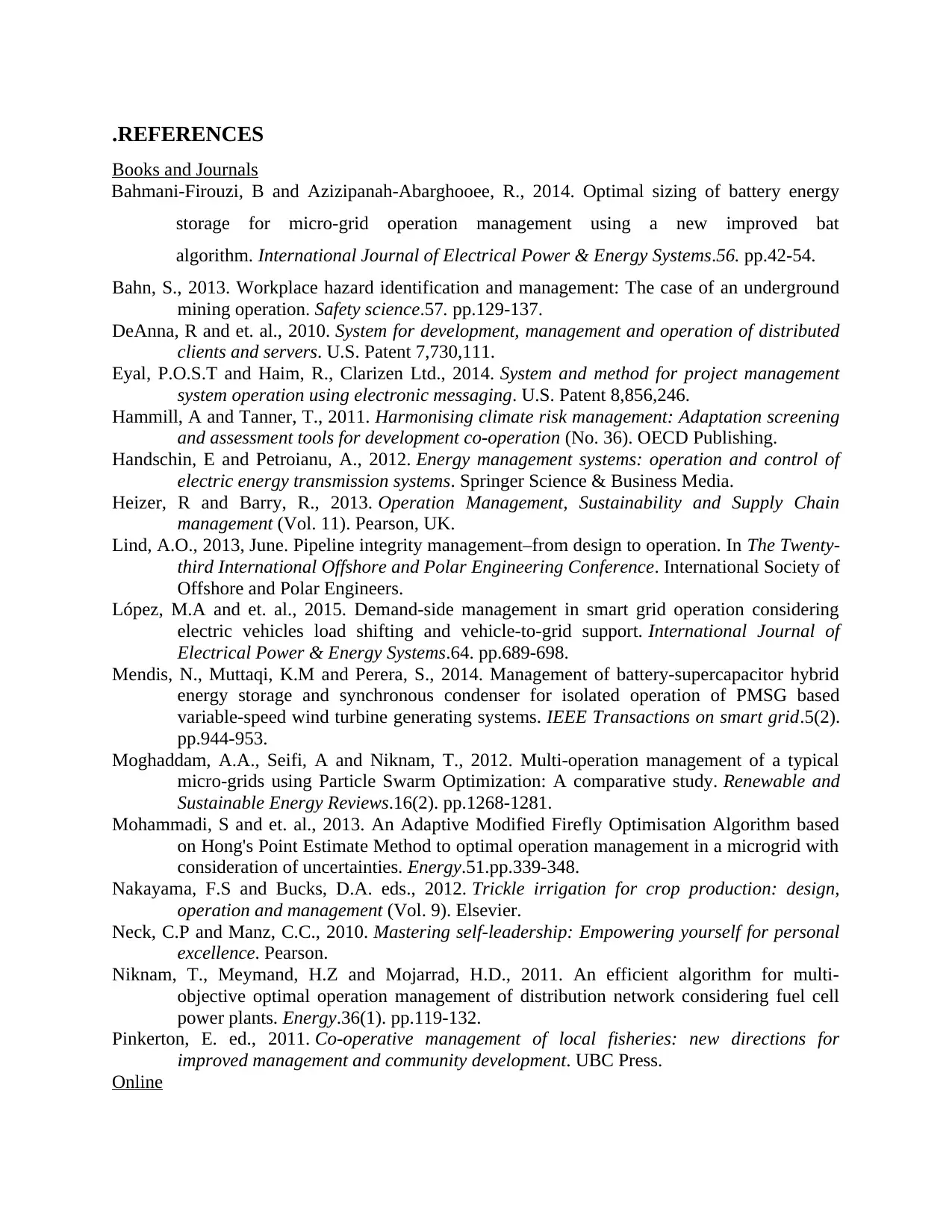
.REFERENCES
Books and Journals
Bahmani-Firouzi, B and Azizipanah-Abarghooee, R., 2014. Optimal sizing of battery energy
storage for micro-grid operation management using a new improved bat
algorithm. International Journal of Electrical Power & Energy Systems.56. pp.42-54.
Bahn, S., 2013. Workplace hazard identification and management: The case of an underground
mining operation. Safety science.57. pp.129-137.
DeAnna, R and et. al., 2010. System for development, management and operation of distributed
clients and servers. U.S. Patent 7,730,111.
Eyal, P.O.S.T and Haim, R., Clarizen Ltd., 2014. System and method for project management
system operation using electronic messaging. U.S. Patent 8,856,246.
Hammill, A and Tanner, T., 2011. Harmonising climate risk management: Adaptation screening
and assessment tools for development co-operation (No. 36). OECD Publishing.
Handschin, E and Petroianu, A., 2012. Energy management systems: operation and control of
electric energy transmission systems. Springer Science & Business Media.
Heizer, R and Barry, R., 2013. Operation Management, Sustainability and Supply Chain
management (Vol. 11). Pearson, UK.
Lind, A.O., 2013, June. Pipeline integrity management–from design to operation. In The Twenty-
third International Offshore and Polar Engineering Conference. International Society of
Offshore and Polar Engineers.
López, M.A and et. al., 2015. Demand-side management in smart grid operation considering
electric vehicles load shifting and vehicle-to-grid support. International Journal of
Electrical Power & Energy Systems.64. pp.689-698.
Mendis, N., Muttaqi, K.M and Perera, S., 2014. Management of battery-supercapacitor hybrid
energy storage and synchronous condenser for isolated operation of PMSG based
variable-speed wind turbine generating systems. IEEE Transactions on smart grid.5(2).
pp.944-953.
Moghaddam, A.A., Seifi, A and Niknam, T., 2012. Multi-operation management of a typical
micro-grids using Particle Swarm Optimization: A comparative study. Renewable and
Sustainable Energy Reviews.16(2). pp.1268-1281.
Mohammadi, S and et. al., 2013. An Adaptive Modified Firefly Optimisation Algorithm based
on Hong's Point Estimate Method to optimal operation management in a microgrid with
consideration of uncertainties. Energy.51.pp.339-348.
Nakayama, F.S and Bucks, D.A. eds., 2012. Trickle irrigation for crop production: design,
operation and management (Vol. 9). Elsevier.
Neck, C.P and Manz, C.C., 2010. Mastering self-leadership: Empowering yourself for personal
excellence. Pearson.
Niknam, T., Meymand, H.Z and Mojarrad, H.D., 2011. An efficient algorithm for multi-
objective optimal operation management of distribution network considering fuel cell
power plants. Energy.36(1). pp.119-132.
Pinkerton, E. ed., 2011. Co-operative management of local fisheries: new directions for
improved management and community development. UBC Press.
Online
Books and Journals
Bahmani-Firouzi, B and Azizipanah-Abarghooee, R., 2014. Optimal sizing of battery energy
storage for micro-grid operation management using a new improved bat
algorithm. International Journal of Electrical Power & Energy Systems.56. pp.42-54.
Bahn, S., 2013. Workplace hazard identification and management: The case of an underground
mining operation. Safety science.57. pp.129-137.
DeAnna, R and et. al., 2010. System for development, management and operation of distributed
clients and servers. U.S. Patent 7,730,111.
Eyal, P.O.S.T and Haim, R., Clarizen Ltd., 2014. System and method for project management
system operation using electronic messaging. U.S. Patent 8,856,246.
Hammill, A and Tanner, T., 2011. Harmonising climate risk management: Adaptation screening
and assessment tools for development co-operation (No. 36). OECD Publishing.
Handschin, E and Petroianu, A., 2012. Energy management systems: operation and control of
electric energy transmission systems. Springer Science & Business Media.
Heizer, R and Barry, R., 2013. Operation Management, Sustainability and Supply Chain
management (Vol. 11). Pearson, UK.
Lind, A.O., 2013, June. Pipeline integrity management–from design to operation. In The Twenty-
third International Offshore and Polar Engineering Conference. International Society of
Offshore and Polar Engineers.
López, M.A and et. al., 2015. Demand-side management in smart grid operation considering
electric vehicles load shifting and vehicle-to-grid support. International Journal of
Electrical Power & Energy Systems.64. pp.689-698.
Mendis, N., Muttaqi, K.M and Perera, S., 2014. Management of battery-supercapacitor hybrid
energy storage and synchronous condenser for isolated operation of PMSG based
variable-speed wind turbine generating systems. IEEE Transactions on smart grid.5(2).
pp.944-953.
Moghaddam, A.A., Seifi, A and Niknam, T., 2012. Multi-operation management of a typical
micro-grids using Particle Swarm Optimization: A comparative study. Renewable and
Sustainable Energy Reviews.16(2). pp.1268-1281.
Mohammadi, S and et. al., 2013. An Adaptive Modified Firefly Optimisation Algorithm based
on Hong's Point Estimate Method to optimal operation management in a microgrid with
consideration of uncertainties. Energy.51.pp.339-348.
Nakayama, F.S and Bucks, D.A. eds., 2012. Trickle irrigation for crop production: design,
operation and management (Vol. 9). Elsevier.
Neck, C.P and Manz, C.C., 2010. Mastering self-leadership: Empowering yourself for personal
excellence. Pearson.
Niknam, T., Meymand, H.Z and Mojarrad, H.D., 2011. An efficient algorithm for multi-
objective optimal operation management of distribution network considering fuel cell
power plants. Energy.36(1). pp.119-132.
Pinkerton, E. ed., 2011. Co-operative management of local fisheries: new directions for
improved management and community development. UBC Press.
Online
⊘ This is a preview!⊘
Do you want full access?
Subscribe today to unlock all pages.

Trusted by 1+ million students worldwide
1 out of 13
Related Documents
Your All-in-One AI-Powered Toolkit for Academic Success.
+13062052269
info@desklib.com
Available 24*7 on WhatsApp / Email
![[object Object]](/_next/static/media/star-bottom.7253800d.svg)
Unlock your academic potential
Copyright © 2020–2025 A2Z Services. All Rights Reserved. Developed and managed by ZUCOL.





